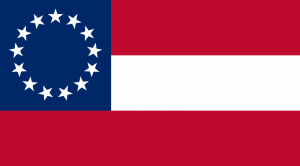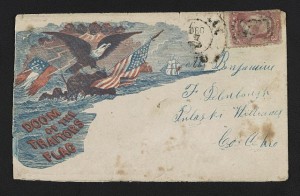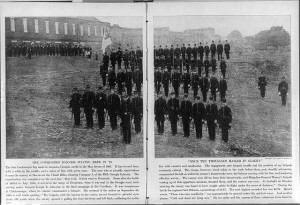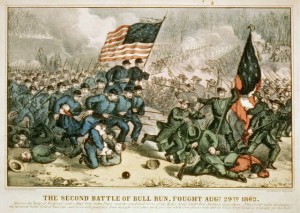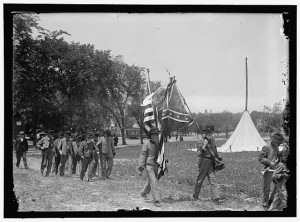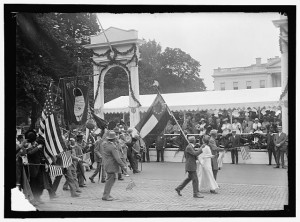This editorial from the South is urging a different flag for the Confederacy. The “Stars and Bars” is too similar to the “Stars and Stripes”. Battlefield uncertainty has even included deaths from friendly fire because of the similarity (“bit the dust” was an expression used 150 years ago). Moreover, if The Confederacy is supposed to be a new venture that breaks the ties to the tyranny of the old Union, shouldn’t the CSA have a fresh flag, not a mere alteration of the despotic “Stars and Stripes”?
From the Richmond Daily Dispatch December 9, 1861:
The Confederate flag.
–We referred in our last to the peculiar difficulties, in a war between people of the same race, of distinguishing friends from foes. Numerous and melancholy have been the instances already in the present contest of friends killed by friends. These are the saddest stories of all — sad for the dead, sad for the living. At Manassas a galling fire was poured by the — Mississippi into the 8th Georgia regiment, already decimated by the enemy, and many a gallant fellow bit the dust. Surely did the former lament their mistake, but too late to recall life or heal wounds. These sad histories must have another depressing and disastrous influence. If soldiers entertain a shadow of doubt as to the character of the columns before them — if there be a remote suspicion that they may be friends — what must be the effect upon their fighting? They cannot half fight — their hands are tired, their nerves unstrung, by the cruel uncertainty. Tears of blood would not suffice could some of the harrowing incidents be here detailed, occasioned by such mistakes.
Numerous well authenticated instances have occurred of mistakes as to the flags, growing entirely out of their close resemblance to each other. We intended to refer to some of these at Charleston, in Western Virginia–to the case of the Minnesota regiment, which escaped capture by this means — to the capture of Col. Boone–but the single instance referred to by Gen. Beauregard himself, in a late speech, is evidence enough and to spare. In the decisive battle of the campaign (at Manassas) a body of troops were seen approaching from the rear of our left wing. Were they friends or enemies? The fate of the battle — almost of the country — depended upon the decision of this question. Although but a little over a mile off, the flag of our rapidly-approaching friends could not be distinguished from that of our foes, even by the aid of powerful glasses. Victory trembled in the balance. How awful the pause of uncertainly! It might have cost the battle. This single fact — and it is but one of many — is enough to excite one universal out-cry against the delusive flag. We have copied from that of our enemies. We have conquered in spite of it.
No wonder that loads of these flags were sent to Richmond by Gen. Jos. Johnston to be altered. But in the name or wisdom, of patriotism, of common sense, let us have a flag that will do to fight under without patching. This is certainly a reasonable demand. Some even talk of a peace flag and a war flag. One flag is surely-enough, and the present is unit for either peace or war. It is so close to the old United States flag that one is on thorough in referring to it, lost he be suspected of treason. We have left the “Stars and Stripes” to our enemies, and are fighting them as the standard of bloody and implacable foes. So we are fain to talk of ours as “Stars and Bars.” How ridiculous we all feel this to be! Shall we perpetuate this nonsense — this mere make shift?
Its unfitness for a war flag is manifest and acknowledged. For what, then, is it fit? In the nature of the case, it can never excite the enthusiasm or devotion of the people. Even victory has not endeared it to them. Our forefathers, wiser than we, when they commenced to fight Great Britain did not adopt some modification of the British flag. They did not try to fight under and against the same thing at the same time. All the glorious achievements of our arms have failed to endear this flag to us. And why? There is a philosophy in it. It is because of its inseparable connection with the despotism against which we are struggling a death struggle. It has a taint about it which cannot be removed. It smells of tyranny — of the old body of death. It wants the virgin freshness of new flag. It is not the old flag, and if it were, the associations of the old have become polluted and corrupt. But we repeat, if the old flag is what we want, we don’t get it. They, our enemies, have the old flag, and we a mere copy. And just here it may be well to remark that we make as much fuss over this flag as if it were the revolutionary flag of our ancestors. But no battle of the Revolution was fought under it. It was never adopted till after peace. It is post revolutionary.
It is high time to repair the unfortunate mistake. We have endeavored to put our new wine into fragments of old bottles. The bottles have burst, and the wine has been spilled. We have gained glorious victories, and the flag is no richer for them. It can never be made to hold. We will never get rid of the taint of that old flag. It is like a marriage ring after a divorce for infidelity. When we hate the marriage, we hate all its mementos.
There is and can be no enthusiasm for this flag, and this is the sole reason. Had we adopted a new one unbounded, independent, already the enthusiastic loyalty of the people to it would have known no bounds. We cannot afford to spill so many victories, and gain no love to the flag. Can we not design a new bottle; without taint, which can hold the loyalty and devotion of the people to the symbol of their country?
The Confederacy had a lot of flags during its four+ year history. The Richmond editor says that the South doesn’t need a “peace flag and a war flag” – but after 150 years it seems that the battle flag (which according to Wikipedia started being used in December 1861) sure became the best known and most strongly associated with the rebel cause.

